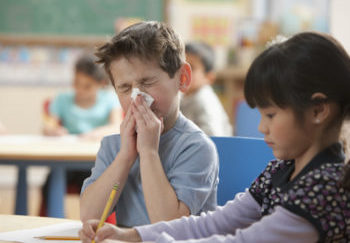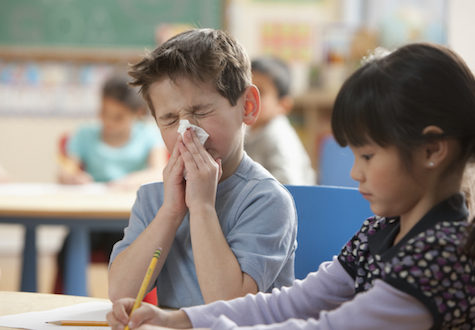
The school year is in full swing, and that means germ swapping has commenced. No matter how many times we tell our kids to wash their hands and use best practices when coughing and sneezing, it doesn’t always happen. As a result, some common illnesses take off this time of year.
Common Illnesses for Fall
We talked to family medicine physician John Davison, MD, about the types of illnesses he and his team are seeing now at UVA Primary Care Riverside and what to expect in the months ahead.
Colds and Upper Respiratory Infections
One of the most common things doctors see this time of year is an uptick in respiratory illnesses like colds. Colds are transmitted when you touch a contaminated surface and then touch your eyes, nose or mouth, which allows the virus to enter your body through the mucus membranes.
Symptoms of the common cold include:
- Sore throat
- Cough
- Runny nose
- Congestion
- Body aches
Colds typically run their course in a week or less and can be managed with over-the-counter symptom relief. But if you or your child runs a fever for more than a few days, or if symptoms persist or worsen, it’s a good idea to see your doctor to rule out an infection.
Feeling Under the Weather?
UVA Primary Care Riverside offers walk-in appointments for mild illnesses and injuries.
Asthma and Seasonal Allergies
We’re not there yet, but colder weather is on the horizon. With the cooler temperatures comes an increase in asthma flare-ups, says Davison. It’s not just the cold air; allergens circulating this time of year can also trigger asthma symptoms.
Symptoms of an allergy attack may include:
- Coughing
- Wheezing
- Difficulty breathing
- Chest pain
If you or your child is asthmatic, be sure to have medication or prescribed treatments at the ready this time of year to control daily symptoms and prevent an attack.
The same goes with seasonal allergy sufferers. Ragweed is a key irritant for many in the fall months. Preventive use of over-the-counter allergy medications can help ease the most common allergy symptoms, including eye irritation, sneezing, runny nose, headache and nasal congestion.
Whooping Cough
Whooping cough or pertussis isn’t as common but has made a comeback in recent years, says Davison. This bacterial infection is highly contagious and can be especially dangerous for young children. The telltale sign that your child has whooping cough is the violent cough followed by a “whooping” sound when they inhale the next breath. Other symptoms include runny nose, sneezing, congestion and difficulty breathing.
Whooping cough requires medical treatment, so see your doctor if you or your child is exhibiting symptoms. Symptoms, namely the cough, can last weeks even after antibiotics clear up the infection. In severe cases, whooping cough may lead to seizures or pneumonia in infants.
The vaccine for whooping cough is the diphtheria-tetanus-pertussis or DTaP, and it’s recommended for all children. Pregnant moms should also get vaccinated at the end of pregnancy so that they develop immunity and can pass that on to the child, says Davison. To be extra safe, grandparents and caregivers should receive a vaccination as well to prevent infecting infants.
Flu
Think it’s too early to worry about flu? Think again. Check back next week for another Germwatch update highlighting all you need to know about protecting yourself and your family this flu season. Subscribe to the Healthy Balance blog today and we’ll send an update right to your inbox.
The Germwatch series provides information on what’s going around in our community as well as popular reasons for primary care visits.
